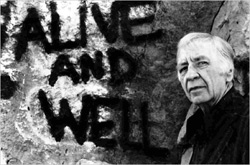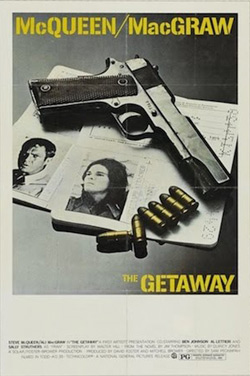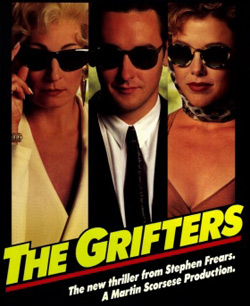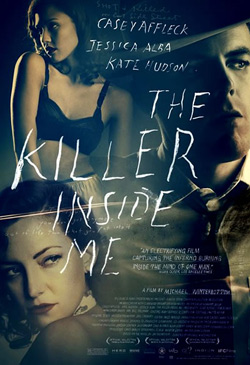
There have been eleven films made from Thompson’s fiction, yet very few of these movies have been able to retain both the darkness and quality of the source material.

The next adaptation was the only other film to appear in Thompson’s lifetime. In 1976, just a year before Thompson’s death, Burt Kennedy directed Stacy Keach in The Killer Inside Me. Thompson hated the film and regretted the deal that signed away the rights to his most famous novel. The film itself is only worth seeing for its camp value. At times it seems like Keach enjoys playing crazy, but ultimately the film portrays psychosis in a heavy-handed, laughable manner.
Since Thompson’s death in 1977 there have been nine more adaptations. Several of the films are over-reliant on neo-noir moodiness and shadows, a problem with This World, Then the Fireworks and Hit Me. But at least these films stick relatively close to the source material.
In 1994, there was yet another ego-fueled adaptation of The Getaway, which has a happy ending and skipped over most of the dark tension of the novel. If you think you’ll get to see Alec Baldwin and Kim Basinger holed up in underwater caves the size of coffins or exiled to a country of cannibals and cutthroats, then it’s best to steer clear.

Another well done, if unlikely, adaptation is Bertrand Tavernier’s Coup de Torchon (Clean Slate). Tavernier changes the location of the novel Pop. 1280 from west Texas to west Africa, but still sticks close enough to the general themes and meaning of the novel to make a film that stands on its own, yet is faithful to Thompson. Tavernier’s film even amplifies some of the humor of the original novel. Phillippe Noiret’s performance as the seemingly-bumbling Police Chief Lucien Cordier holds on to the “I’m not saying you’re wrong, but I’m not saying you’re right” hokiness of Sherriff Nick Corey and pulls out the subtle comedic aspects of the character.
It’s not too surprising that the best Thompson films are the ones that stuck closest to the novels, but that might actually be a problem with the most recent movie. Michael Winterbottom’s The Killer Inside Me features a bravura performance by Casey Affleck and is probably the most faithful of Thompson’s adaptations. But this very faithfulness may point to the answer as to why Thompson and his work have had such trouble on the big screen.

So, is it actually possible that Thompson’s books are too intense for movies—too graphic for faithful transference into a visual format?
Jim Thompson wrote some of the most bizarre, disturbing and just plain good literature of the twentieth century. He not only wrote characters who committed unimaginable crimes, he also wrote novels that stretched the boundaries of the crime genre and the form of the novel itself. But maybe on some level Thompson’s creations are un-adaptable. Maybe his vision of America is just too damn scary to put on the big screen without some sort of filter over the material. After all, Steve McQueen and Ali McGraw are pretty damn good in The Getaway—it’s just not Jim Thompson’s Getaway.
With a little luck, despite the track record, other filmmakers will keep giving Thompson a shot, though I have a funny feeling he might not ever get the credit he deserves, just as happened every time he worked with Stanley Kubric. Thompson, ever the masochist, actually worked with Kubric a third time after being dismissed so thoroughly the first two. Together, they came up with an idea and Thompson wrote an extended screen treatment called Lunatic at Large. Kubrick thought he lost it on a train, but the treatment was found in 1999 and is in pre-production with Sam Rockwell and Scarlett Johansson attached. But of course, in a twist Thompson could have predicted, Lunatic at Large is already being framed and marketed as a lost Kubrick film. Even from the grave, Kubrick is stepping on Big Jim’s authorial toes.
Richard Z. Santos lives outside of Austin and is enrolled in the MFA program at Texas State University. Once, he worked in Washington, DC, but now he doesn’t do much more than write and teach. He blogs at Paperclip People, and is working on his first novel—a crime thriller set in New Mexico.

Well done, Richard. Jim Thompson’s novels reveal that any one of us could cross the line as his seemingly ordinary characters did, and that unsettling fact will resonate with readers forever.
In a New York Times article last year, Charles McGrath suggested that European directors have had the best luck adapting Thompson’s novels. True enough, but both that article and this blog ignore James Foley’s brilliant 1990 adaptation of After Dark, My Sweet. It’s remarkable film noir and features one of Bruce Dern’s best performances. Jason Patric gives an astonishing, star-making turn in the lead role. It was ignored by audiences but some of America’s more astute film critics (Roger Ebert, for one) recognize it as one of modern film noir’s most masterfully crafted gems. Plus, it has the added bonus of introducing me to the work of Jim Thompson when I was a high school kid. I can remember writing a pretentious university essay about the film, comparing it to Blue Velvet. James Foley is one of America’s most underrated filmmakers. With video stores disappearing it’s becoming harder and harder to find films such as After Dark My Sweet, or his equally brilliant 1986 crime drama At Close Range. They are worth seeking out.